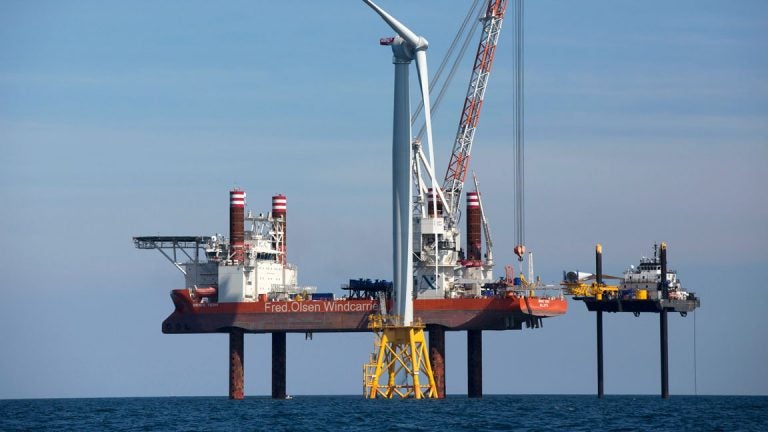Two big steps made in push for NJ offshore-wind industry
The developments mark big steps by N.J. in advancing its oft-stated goal to become the hub of the supply chain to service multiple offshore-wind farms on the East Coast.

Aug. 15, 2016, a wind turbine, front, being assembled off Block Island, Rhode Island. (Michael Dwyer/AP Photo)
This article originally appeared on NJ Spotlight.
—
The state is directing $13.2 million to begin transforming 200 acres along Delaware Bay into the nation’s first port exclusively geared to serving the burgeoning offshore-wind industry developing along the Eastern Seaboard.
The action by the New Jersey Board of Public Utilities came after the agency also approved Wednesday the acquisition by PSEG Renewable, a subsidiary of the Public Enterprise Group of a 25% interest in Ørsted’s Ocean Wind offshore-wind farm, the first such project to be built off the Jersey coast.
The twin developments mark significant steps by the Murphy administration in advancing its oft-stated goal to become the hub of the supply chain to service multiple offshore-wind farms not only off New Jersey, but up and down the Atlantic coast. The region, with a relatively wide and shallow continental shelf and consistent winds, is especially suited for offshore wind.
Earlier this month, Gov. Phil Murphy pledged to spend $200 million to develop a new port on Artificial Island in Salem County, near three nuclear power plants operated by PSEG Nuclear, LLC. That money is included in the administration’s budget proposal for the next fiscal year, which begins July 1. Lawmakers are now reviewing the budget proposal.
The $13.2 million is coming out of the Societal Benefits Charge, a surcharge on utility customers’ bills. In the 2018 fiscal year, it raised more than $700 million for a wide range of programs — mostly for clean-energy projects and a low-income energy assistance program.
The hub of the supply chain
“We are talking about 200 acres for the wind port. It really positions New Jersey as the hub of the supply chain for the sector,’’ said BPU President Joseph Fiordaliso. At the New Jersey Wind Port, the initial phase will focus on a 30-acre parcel where the massive wind turbines and towers, also called monopiles, will be assembled before being towed to the offshore-wind farms.
Eventually, the state hopes to attract manufacturers to build the cables and other necessary components that could draw offshore-wind projects to use the port, which officials estimate could eventually employ as many as 15,000 workers. New Jersey faces stiff competition from other states, such as New York, for the jobs that could build a robust green economy.
The purchase of an interest in Ørsted’s 1,100-megawatt offshore-wind project gives PSEG a foothold in the sector. PSEG is expected to coordinate the development, permitting and construction of the onshore portions of the project’s interconnection and transmission facilities, according to the BPU order.
Because of PSEG’s extensive experience in New Jersey, it will help develop a ‘’robust interconnection strategy that minimizes schedule risk and cost risk to New Jersey customers,’’ according to a petition by the companies seeking BPU approval.
Perhaps, more significantly, the petition indicated that PSEG will be responsible for scheduling and dispatch of the project’s energy output once the wind farm is operational. That provision will ensure that revenues from the project, which are returned to ratepayers, are optimized, according to the company.

Get daily updates from WHYY News!
WHYY is your source for fact-based, in-depth journalism and information. As a nonprofit organization, we rely on financial support from readers like you. Please give today.





